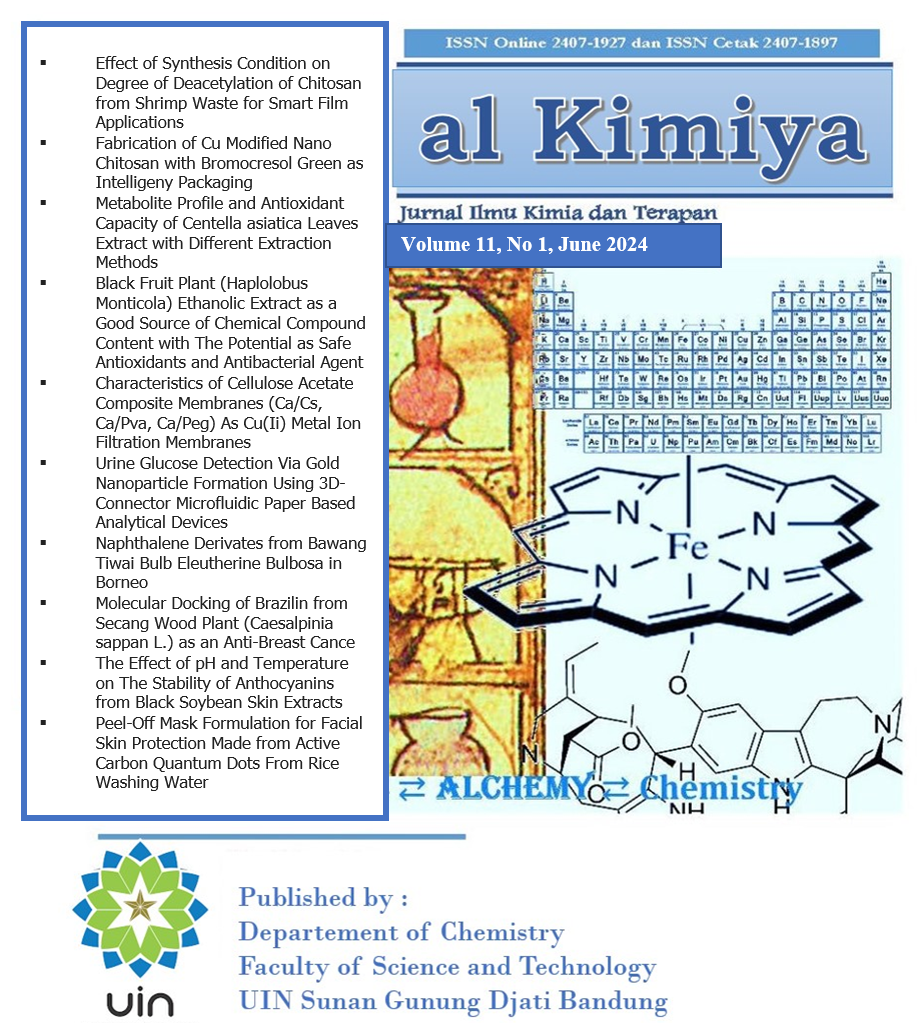Urine Glucose Detection Via Gold Nanoparticle Formation Using 3D-Connector Microfluidic Paper Based Analytical Devices
DOI:
https://doi.org/10.15575/ak.v11i1.35245Keywords:
Diabetes mellitus, glucose, μPADs, AuNPs, non-invasiveAbstract
References
Z. Punthakee, R. Goldenberg, and P. Katz, “Definition, classification and diagnosis of diabetes, prediabetes and metabolic syndrome,†Can J Diabetes, 42, S10–S15, Apr. 2018, https://doi.org/10.1016/j.jcjd.2017.10.003
O. A. Ojo, H. S. Ibrahim, D. E. Rotimi, A. D. Ogunlakin, and A. B. Ojo, “Diabetes mellitus: From molecular mechanism to pathophysiology and pharmacology,†Sep. 01, 2023, https://doi.org/10.1016/j.medntd.2023.100247
A. T. Kharroubi, “Diabetes mellitus: The epidemic of the century,†World J Diabetes, 6(6), 850, 2015,
https://doi.org/10.4239/wjd.v6.i6.850
X. Lin et al., “Global, regional, and national burden and trend of diabetes in 195 countries and territories: an analysis from 1990 to 2025,†Sci Rep, 10(1), Dec. 2020,
https://doi.org/10.1038/s41598-020-71908-9
M. A. B. Khan, M. J. Hashim, J. K. King, R. D. Govender, H. Mustafa, and J. Al Kaabi, “Epidemiology of type 2 diabetes - global burden of disease and forecasted trends,†J Epidemiol Glob Health, 10(1), 107–111, Mar. 2020,
https://doi.org/10.2991/jegh.k.191028.001
W. V. Gonzales, A. T. Mobashsher, and A. Abbosh, “The progress of glucose monitoring—A review of invasive to minimally and non-invasive techniques, devices and sensors,†Sensors, 19(800), 1–45, Feb. 2019,
https://doi.org/10.3390/s19040800
K. Khachornsakkul, F. J. Rybicki, and S. Sonkusale, “Nanomaterials integrated with microfluidic paper-based analytical devices for enzyme-free glucose quantification,†Talanta, 260(124538), 1–9, Aug. 2023,
https://doi.org/10.1016/j.talanta.2023.124538
S. Liu, W. Su, and X. Ding, “A review on microfluidic paper-based analytical devices for glucose detection,†MDPI AG. Dec. 01, 2016,
https://doi.org/10.3390/s16122086
J. Sun, Y. Xianyu, and X. Jiang, “Point-of-care biochemical assays using gold nanoparticle-implemented microfluidics,†Royal Society of Chemistry, Sep. 07, 2014,
https://doi.org/10.1039/C4CS00125G
O. Tokel, F. Inci, and U. Demirci, “Advances in plasmonic technologies for point of care applications,†American Chemical Society, Jun. 11, 2014,
https://doi.org/10.1021/cr4000623
T. Tian, J. Li, Y. Song, L. Zhou, Z. Zhu, and C. J. Yang, “Distance-based microfluidic quantitative detection methods for point-of-care testing,†Royal Society of Chemistry, Apr. 07, 2016,
https://doi.org/10.1039/C5LC01562F
T. Pinheiro et al., “Paper-based in-situ gold nanoparticle synthesis for colorimetric, non-enzymatic glucose level determination,†Nanomaterials, 10(10), 1–20, Oct. 2020,
https://doi.org/10.3390/nano10102027
T. Pinheiro, A. C. Marques, P. Carvalho, R. Martins, and E. Fortunato, “Paper microfluidics and tailored gold nanoparticles for nonenzymatic, colorimetric multiplex biomarker detection,†ACS Appl Mater Interfaces, 13(3), 3576–3590, Jan. 2021,
https://doi.org/10.1021/acsami.0c19089
L. Yang, Z. Zhang, and X. Wang, “A microfluidic PET-based electrochemical glucose sensor,†Micromachines (Basel), 13(552), 1–8, Apr. 2022,
https://doi.org/10.3390/mi13040552
Z. Liu, F. Zhao, S. Gao, J. Shao, and H. Chang, “The applications of gold nanoparticle-initialed chemiluminescence in biomedical detection,†Springer New York LLC, Dec. 01, 2016,
https://doi.org/10.1186/s11671-016-1686-0
L. Liang et al., “Aptamer-based fluorescent and visual biosensor for multiplexed monitoring of cancer cells in microfluidic paper-based analytical devices,†Sens Actuators B Chem, 229, 347–354, Jun. 2016,
https://doi.org/10.1016/j.snb.2016.01.137
C. Li, Y. Liu, X. Zhou, and Y. Wang, “A paper-based SERS assay for sensitive duplex cytokine detection towards the atherosclerosis-associated disease diagnosis,†J Mater Chem B, 8(16), 3582–3589, Apr. 2020,
https://doi.org/10.1039/C9TB02469G
M. Rahbar, A. R. Wheeler, B. Paull, and M. Macka, “Ion-exchange based immobilization of chromogenic reagents on microfluidic paper analytical devices,†Anal Chem, 91(14), 8756–8761, Jul. 2019,
https://doi.org/10.1021/acs.analchem.9b01288
Y. Zhang et al., “Distance-based detection of Ag+ with gold nanoparticles-coated microfluidic paper,†J Anal Test, 5(1), 11–18, Mar. 2021,
https://doi.org/10.1007/s41664-021-00157-0
K. K. Bharadwaj et al., “Green synthesis of gold nanoparticles using plant extracts as beneficial prospect for cancer theranostics,†Molecules, 26(6389), 1–41, Nov. 2021,
https://doi.org/10.3390/molecules26216389
T. Medina, S. Erlangga, A. Bayu, D. Nandiyanto, and M. Fiandini, “Analisis tekno-ekonomi pada produksi nanopartikel emas (aunp) dengan metode biosintesis menggunakan sargassum horneri pada skala industri,†Jurnal Teknik Industri (JURTI), 1(2), 103–110, 2022,
https://doi.org/10.30659/jurti.1.2.103-110
F. Y. Kong, J. W. Zhang, R. F. Li, Z. X. Wang, W. J. Wang, and W. Wang, “Unique roles of gold nanoparticles in drug delivery, targeting and imaging applications,†Molecules, 22(1445), 1–13, Sep. 2017,
https://doi.org/10.3390/molecules22091445
E. Ferrari, “Gold nanoparticle-based plasmonic biosensors,†Biosensors (Basel), 13(411), 1–16, Mar. 2023,
https://doi.org/10.3390/bios13030411
J. B. Vines, J.-H. Yoon, N.-E. Ryu, D.-J. Lim, and H. Park, “Gold nanoparticles for photothermal cancer therapy,†Front Chem, 7(167), 1–16, 2019,
https://doi.org/10.3389/fchem.2019.00167
S. Amaliyah, D. P. Pangesti, M. Masruri, A. Sabarudin, and S. B. Sumitro, “Green synthesis and characterization of copper nanoparticles using piper retrofractum vahl extract as bioreductor and capping agent,†Heliyon, 6(e0636), 1–12, Aug. 2020,
https://doi.org/10.1016/j.heliyon.2020.e04636
G. A. Isola, M. K. Akinloye, Y. K. Sanusi, P. S. Ayanlola, and G. A. Alamu, “Optimizing x-ray imaging using plant mediated gold nanoparticles as contrast agent: A review,†International Journal of Research and Scientific Innovation, 08(08), 169–175, 2021,
https://doi.org/10.51244/IJRSI.2021.8809
S. Suvarna et al., “Synthesis of a novel glucose capped gold nanoparticle as a better theranostic candidate,†PLoS One, 12(6), 1–15, Jun. 2017,
https://doi.org/10.1371/journal.pone.0178202
N. J. Lang, B. Liu, and J. Liu, “Characterization of glucose oxidation by gold nanoparticles using nanoceria,†J Colloid Interface Sci, 428, 78–83, Aug. 2014,
https://doi.org/10.1016/j.jcis.2014.04.025
W. Agudelo, Y. Montoya, and J. Bustamante, “Using a non-reducing sugar in the green synthesis of gold and silver nanoparticles by the chemical reduction method,†DYNA (Colombia), 85(206), 69–78, Jul. 2018,
Downloads
Published
How to Cite
Issue
Section
Citation Check
License
Authors who publish with this journal agree to the following terms:
- Authors retain copyright and grant the journal right of first publication with the work simultaneously licensed under a Creative Commons Attribution 4.0 International License that allows others to share the work with an acknowledgment of the work's authorship and initial publication in this journal.
- Authors are able to enter into separate, additional contractual arrangements for the non-exclusive distribution of the journal's published version of the work (e.g., post it to an institutional repository or publish it in a book), with an acknowledgment of its initial publication in this journal.
- Authors are permitted and encouraged to post their work online (e.g., in institutional repositories or on their website) prior to and during the submission process, as it can lead to productive exchanges, as well as earlier and greater citation of published work (See The Effect of Open Access).






